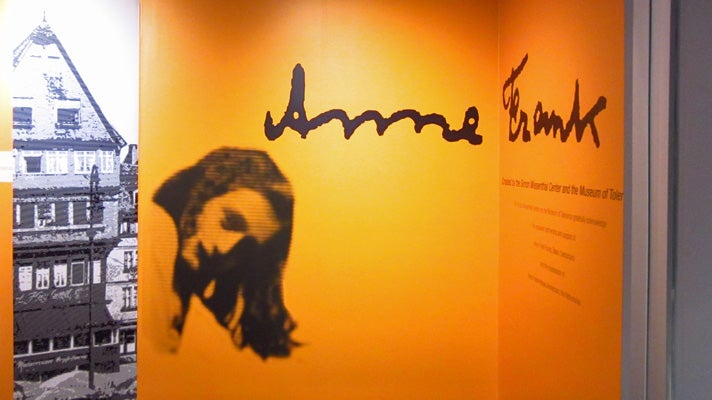Anne is a moving and inspiring exhibit now on view at the Simon Wiesenthal Center’s Museum of Tolerance (MOT) in West L.A. The exhibit, which opened in October 2013, is a multi-media experience that chronicles the life and legacy of Anne Frank, a young Jewish girl who gained international fame after the posthumous publication of her diary, which documents her experiences while in hiding with her family during the German occupation of the Netherlands during World War II. The goal of the 9,000 square-foot exhibit is to place Anne’s story in the proper historical context, through the use of immersive environments, unique artifacts, and interactive media. Click through to read selected highlights from this remarkable exhibit.
Anne is not included with general admission to MOT. Tickets to Anne are priced at $15.50 for adults, $13.50 for seniors, and $12.50 for students. Advanced reservations are highly recommended. Call 310.772.2506 to reserve your tickets.
FRANKFURT
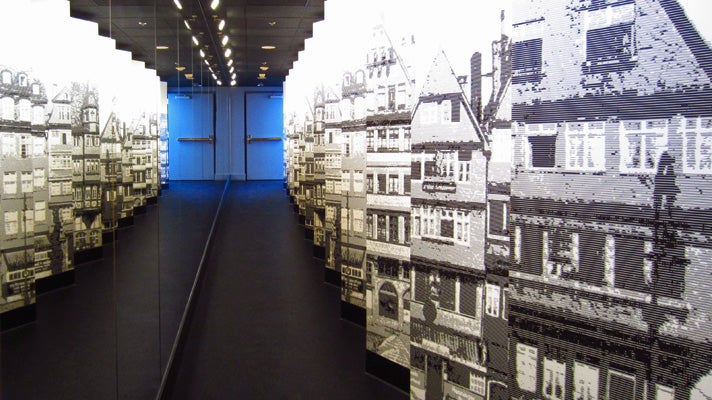
The experience begins with an image of Anne Frank and a graphic of her signature. The visitor enters a hallway that evokes a street scene from Frankfurt, Germany in 1932. To create the impression, a row of gabled facades has been silkscreened onto a zigzag wall and reflected in mirrors lining the left side of the hallway.
DREAMS OF HOLLYWOOD
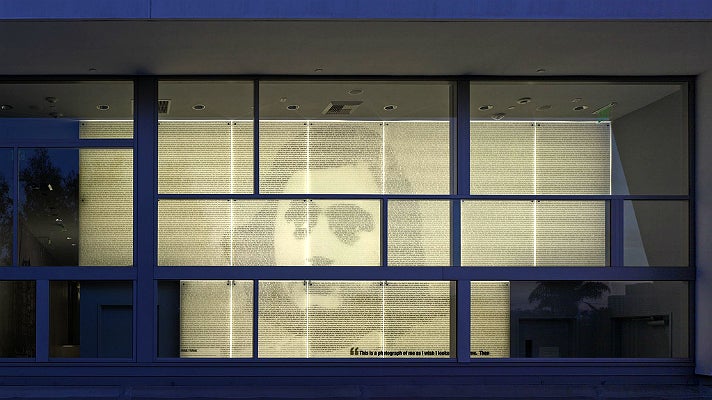
Anne dreamed of someday becoming an actress. After three months of hiding, Anne pasted a photo of herself in her diary. "This is a photograph of me as I wish I looked all the time,” she wrote. “Then I might still have a chance of getting to Hollywood. But at present, I'm afraid, I usually look quite different." Around the corner from the Frankfurt street scene, a huge version of Anne’s photo emerges from a mural of words from her diary. The placement is not a coincidence - her backlit, shadowy image faces the Hollywood sign in the distance, a nod to her dreams of stardom.
WESTERTOREN CLOCK
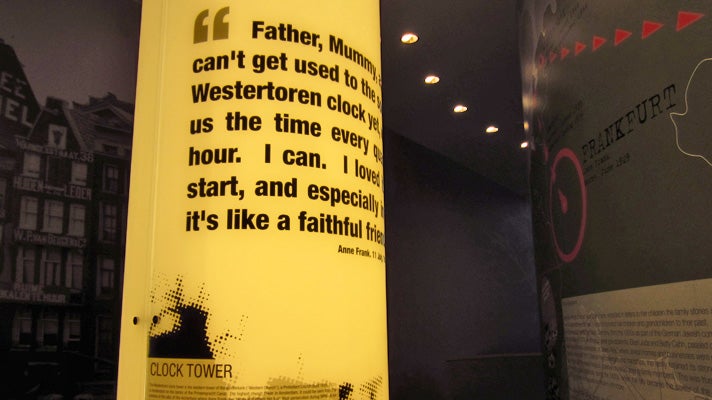
In one of her early diary entries, dated July 11, 1942, Anne wrote, “Daddy, Mummy, and Margot can’t get used to the sound of the Westertoren clock yet, which tells us the time every quarter of an hour. I can. I loved it from the start, and especially in the night it’s like a faithful friend.” The church is mentioned frequently in Anne’s diary - the clock tower could be seen from the Secret Annex. The exhibit features an actual recording of the Westertoren clock, which chimes every 15 minutes.
FAMILY TREE
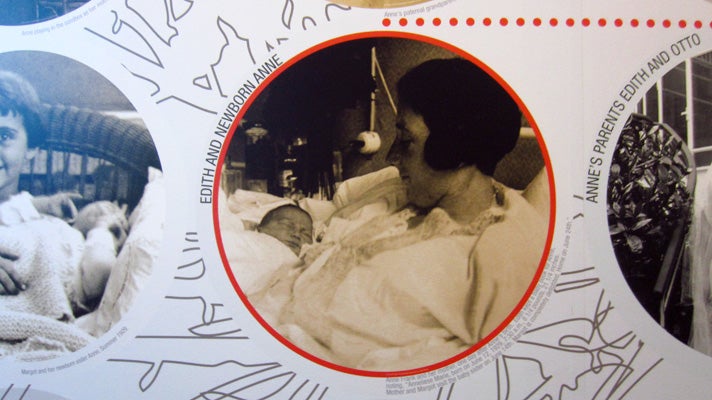
Anne Frank’s family tree is depicted on a floor-to-ceiling wall map, tracing Anne’s roots throughout Europe. Frankfurt am Main was home to the Frank family since the 1600s, and it was where Annelies "Anne" Marie Frank was born on June 12, 1929. The map follows their journey from Frankfurt to Amsterdam and their ultimate fates at Westerbork, Auschwitz and Bergen-Belsen.
BUDDY ELIAS: MEMORIES OF A COUSIN
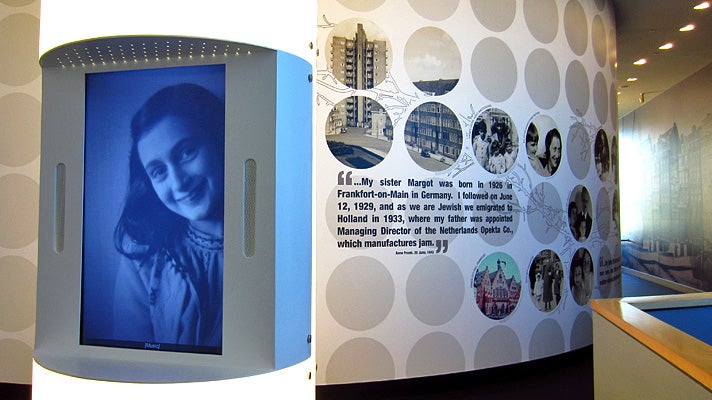
Just beyond the map is a media station that plays an interview with Anne’s only living relative, her cousin Buddy Elias, who talks about his childhood memories of Anne. On the wall opposite the station, silent black-and-white footage plays on a loop, showing everyday life in pre-war Amsterdam. Anne can be briefly glimpsed leaning from a second-floor window, in a 1941 film made for her newlywed next-door neighbor. It’s the only known footage of Anne Frank in existence.
CHESTNUT TREE
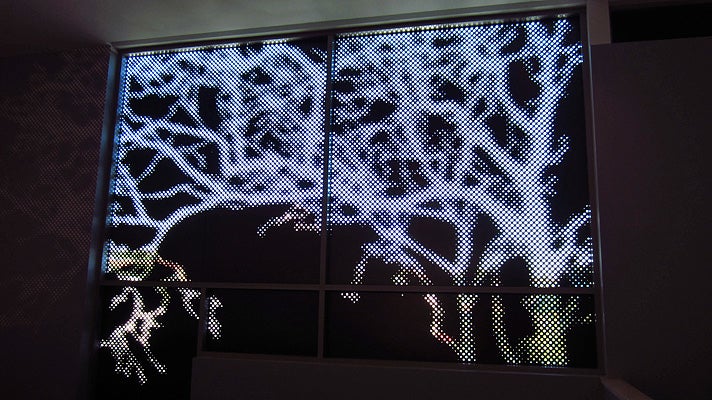
Anne could see a chestnut tree through the only window that wasn’t blacked out in the attic. In an entry dated Feb. 23, 1944, she wrote, “Nearly every morning I go to the attic to blow the stuffy air out of my lungs, from my favorite spot on the floor I look up at the blue sky and the bare chestnut tree, on whose branches little raindrops shine, appearing like silver, and at the seagulls and other birds as they glide on the wind. As long as this exists, I thought, and I may live to see it, this sunshine, the cloudless skies, while this lasts I cannot be unhappy.” A double flight of stairs leads visitors past an etched image of Anne’s beloved chestnut tree.
INFINITY WALL
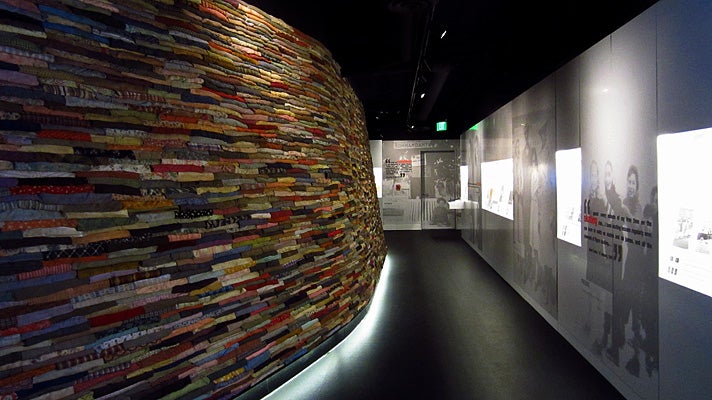
On the lower level, an “infinity wall” guides visitors through the exhibit. The wall is lined with folded clothes, inspired by images of stacks of uniforms worn by gas chamber victims. The clothing is initially brightly colored, representing Anne’s happy childhood. As the exhibit continues, the colors of the clothes grow darker and the wall begins to close in. There are 17,528 articles of clothing - multiplied 90 times, it equals 1.5 million. The devastating conclusion: it would take the clothing of 90 Anne exhibits to equal the 1.5 million children murdered by the Nazis during the Holocaust. The infinity wall also underscores the point that Anne’s story is not unique, but one of many.
ANNE’S STORY
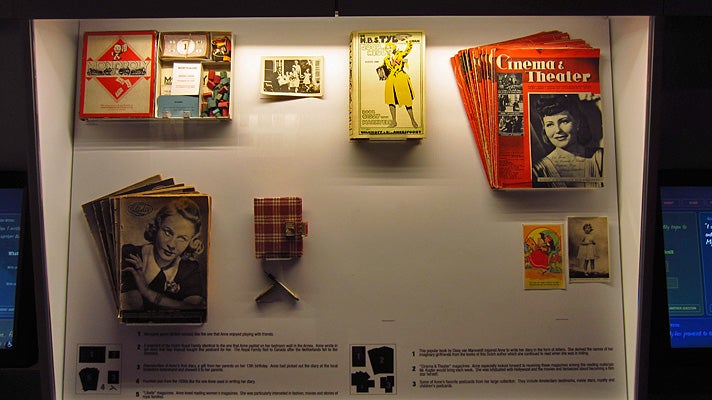
Actress Hailee Steinfeld, an Academy Award® nominee for the 2010 film True Grit, brings Anne’s words to life through her narration, which is heard throughout the exhibit. Steinfeld’s narration is augmented by numerous displays of artifacts that range from postcards, photos and magazines to games, letters to pen pals, and a reproduction of Anne’s blank diary, a gift on her thirteenth birthday.
THE BOOKCASE
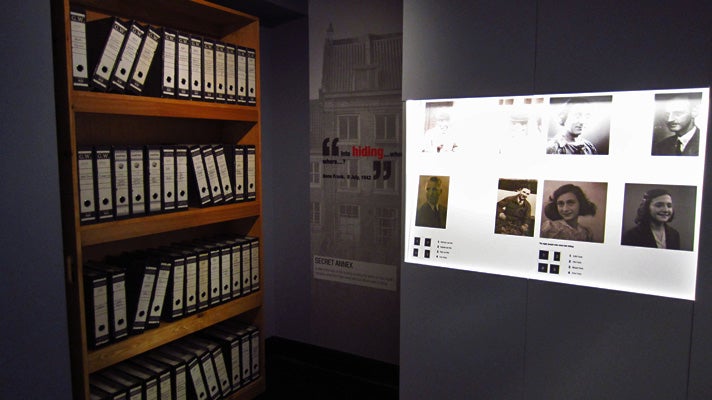
Continuing through the exhibit, the colorful infinity wall has turned gray. Displays paint an increasingly desperate picture for the Frank family - hiding is the only option. On July 6, 1942, the Frank family moved into the Achterhuis (“Secret Annex”), a three-story space entered from a landing above the offices of Otto Frank’s firm, Opekta Works. Only four trusted employees knew that the Frank family - and later the van Pels family and Fritz Pfeffer - were hiding in the Secret Annex. The door to the Secret Annex was hidden by a bookcase. At the MOT, a replica of the bookcase opens and visitors enter the “Secret Annex.”
THE SECRET ANNEX EXPERIENCE
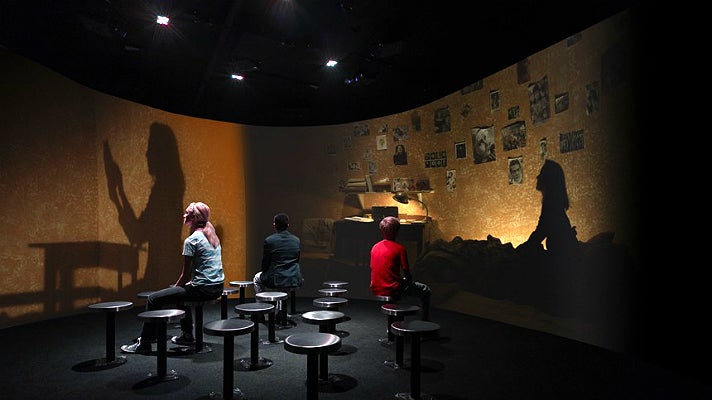
Inside, visitors are seated in a 260-degree, circular theatre that approximates the size of the actual Secret Annex. A nine-minute film, projected in the round, immerses viewers in Anne’s two-year seclusion. The experience is enhanced by Steinfeld’s voice, diary excerpts, silhouettes of Anne and her fellow occupants, and audio-visual effects that convey everything from life in the annex to the harrowing sounds of nearby gunfire.
BERGEN-BELSEN
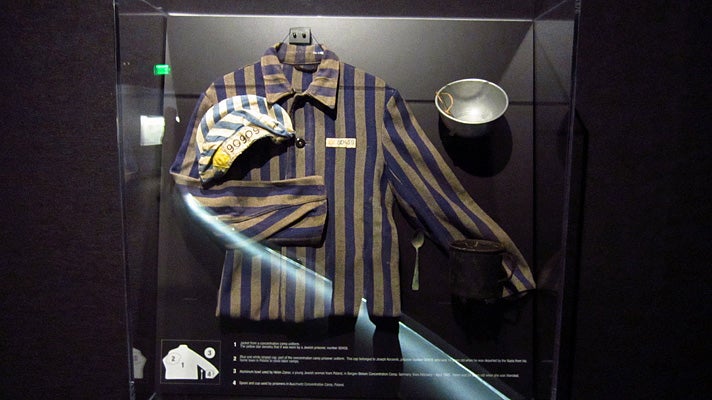
After exiting the theatre, visitors can see the infinity wall is as black as coal. On display is a concentration camp uniform, while nearby four video screens tell the final, terrible chapter of Anne Frank’s story. The diary’s last entry is dated August 1, 1944. Anne and those hiding with her were betrayed by an informant, who remains unknown to this day. On August 4, 1944, the Secret Annex was raided and the group was arrested. They were detained at Westerbork transit camp and deported to the Auschwitz concentration camp. There, the men and women were separated. Anne and her sister Margot, along with fellow annex occupant Auguste van Pels, were eventually transported to Bergen-Belsen. Anne and Margot died just a few weeks before the camp was liberated by British troops on April 15, 1945. Otto Frank would be the only survivor of the group of eight from the Secret Annex.
“THE DIARY OF A YOUNG GIRL”
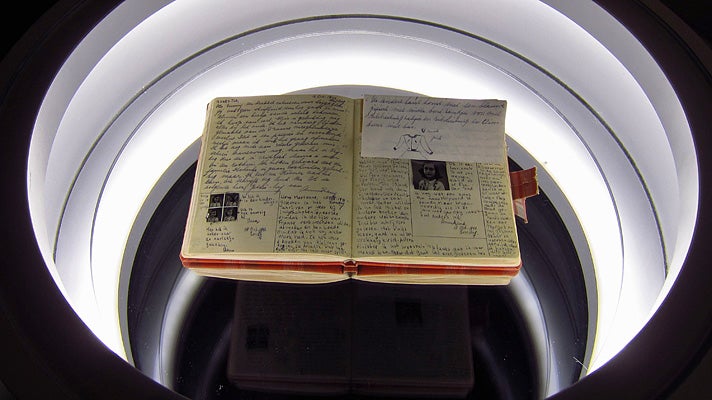
After the war, Otto Frank returned to Amsterdam. Anne’s diary and notes, along with other Frank family possessions, were rescued by Miep Gies and Bep Voskuijl, two of Otto’s employees who helped hide the group in the Secret Annex. Otto’s efforts led to the diary’s publication in 1947, under the title The Annex: Diary Notes 14 June 1942 – 1 August 1944 by Contact Publishing in Amsterdam. The diary received widespread critical and public attention after the English language translation, Anne Frank: The Diary of a Young Girl was published in 1952 by Doubleday & Company (United States) and Valentine Mitchell (United Kingdom). The final artifact of the exhibit is a detailed replica of the world-famous diary, mounted in a sleek display case.
A MESSAGE OF HOPE
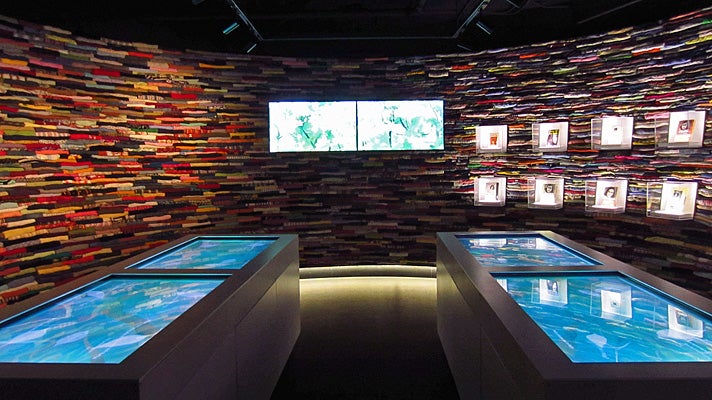
On July 15, 1944, Anne wrote one of her most quoted entries, which includes this hopeful message: “It's a wonder I haven't abandoned all my ideals, they seem so absurd and impractical. Yet I cling to them because I still believe, in spite of everything, that people are truly good at heart.” It is this optimism that informs the final gallery. Touchscreens prompt visitors to reflect on their own lives and make the world a better place, with lessons from the diary such as Assuming Responsibility, Appreciating Nature, Speaking Up and Valuing Family. Enclosed by an infinity wall that is once again brightly colored, visitors are asked to make pledges of their own, which are then displayed on screen.
TRANSLATIONS FROM AROUND THE WORLD
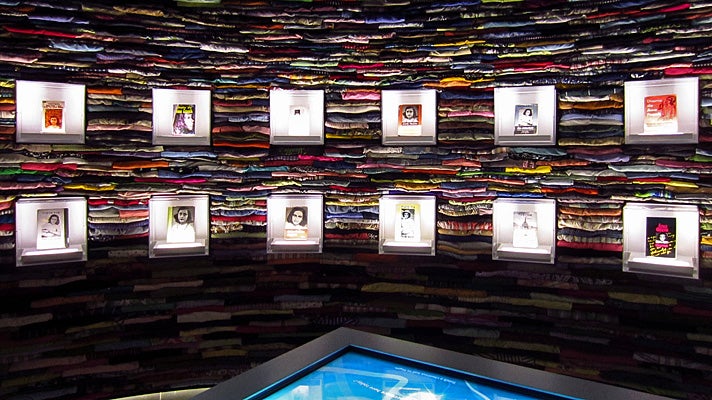
The Diary of a Young Girl has been translated into 70 languages and published in more than 60 countries. The diary inspired the 1955 play The Diary of Anne Frank, its 1959 film adaption, and numerous works of art, music and literature. The final gallery of the Anne exhibit displays translated versions of the diary from around the world, a testament to the global influence and enduring legacy of Anne Frank.



